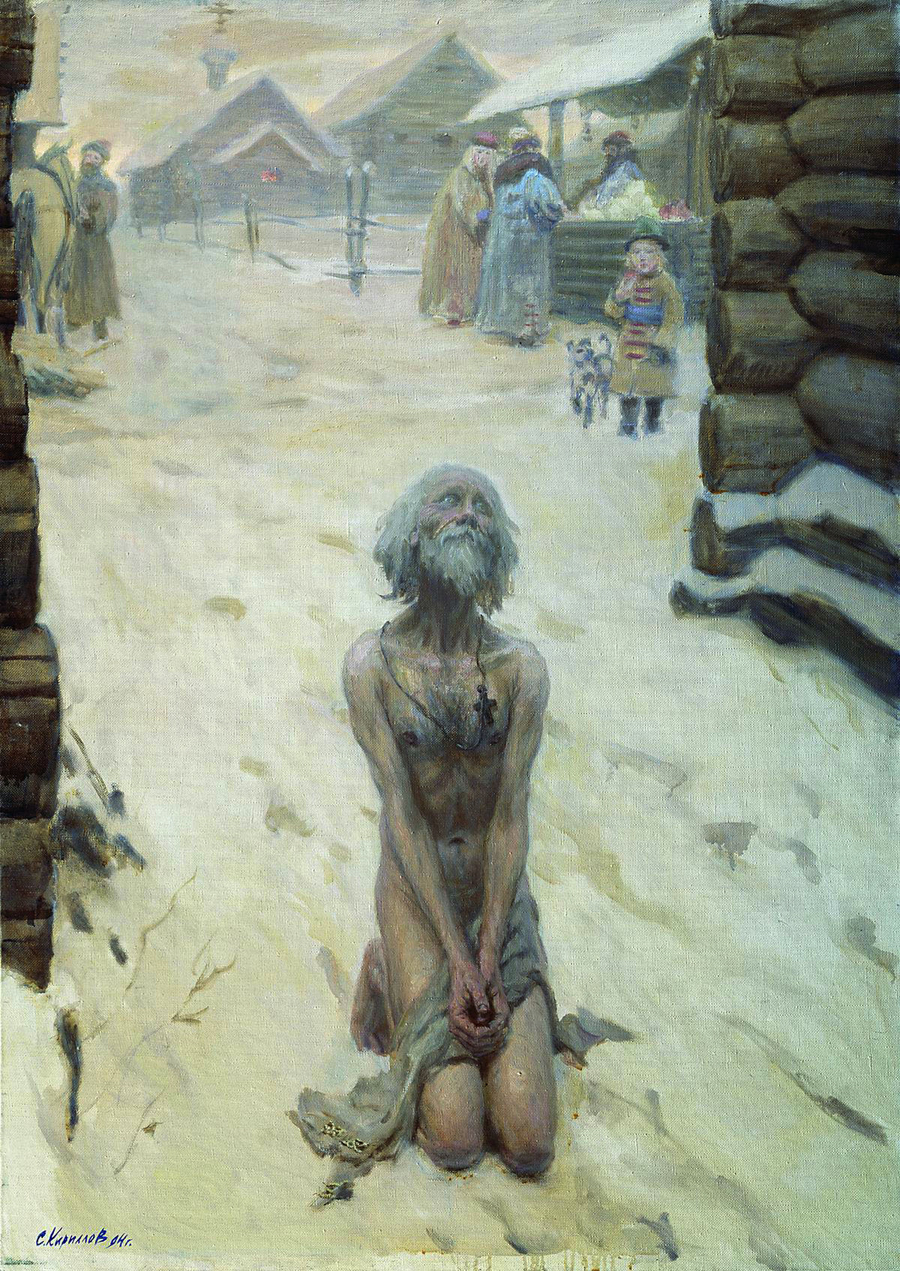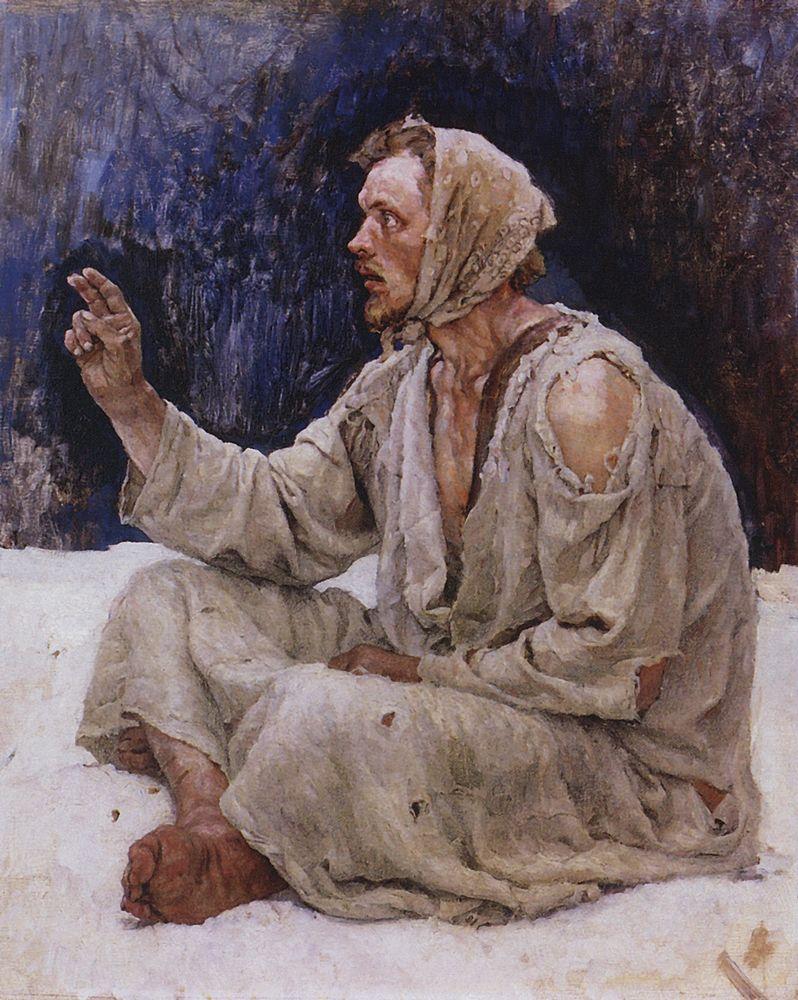|
John Of Moscow
John of Moscow also known as Blessed John the Fool for Christ was a 16th-century Russian saint. He was born on the outskirts of Vologda in Russia. He was considered a wonderworker in Moscow and spent his youth as a labourer in a local saltworks and as a water-carrier. John made his work a spiritual discipline in conjunction with a strict commitment to fasting and personal prayer. Eventually he relocated to the community of Rostov, where he began his exploit of holy foolishness for the sake of Christ. He wore chains with heavy iron crosses, and on his head was a heavy iron cap, for which they called him "John Big-Cap". In Moscow he went barefoot and almost naked in even the most severe frost, and he foretold the great misfortunes for Russia, the Time of Troubles and the incursion of the Poles, saying that "in Moscow will be many visible and invisible devils John is said to have spoken the truth without fear, even to those of the highest social or political status such the Czar ... [...More Info...] [...Related Items...] OR: [Wikipedia] [Google] [Baidu] |
Foolishness For Christ
Foolishness for Christ (; ) refers to behavior such as giving up all one's worldly possessions upon joining an ascetic order or religious life, or deliberately flouting society's conventions to serve a religious purpose—particularly of Christianity. Such individuals have historically been known as both "holy fools" and "blessed fools". The term "fool" connotes what is perceived as feeblemindedness, and " blessed" or "holy" refers to innocence in the eyes of God.Frith, Uta. (1989) Autism: The Elegant Enigma. Malden, MA: Blackwell Publishing. The term ''fools for Christ'' derives from the writings of Paul the Apostle. Desert Fathers and other saints acted the part of Holy Fools, as have the ''yurodivy'' (or iurodstvo) of Eastern Orthodox asceticism. Fools for Christ often employ shocking and unconventional behavior to challenge accepted norms, deliver prophecies, or to mask their piety.Parry (1999), p. 233 Old Testament Certain prophets of the Old Testament who exhibited sign ... [...More Info...] [...Related Items...] OR: [Wikipedia] [Google] [Baidu] |
Russian Hermits
Russian(s) may refer to: *Russians (), an ethnic group of the East Slavic peoples, primarily living in Russia and neighboring countries *A citizen of Russia *Russian language, the most widely spoken of the Slavic languages *''The Russians'', a book by Hedrick Smith *Russian (comics), fictional Marvel Comics supervillain from ''The Punisher'' series *Russian (solitaire), a card game * "Russians" (song), from the album ''The Dream of the Blue Turtles'' by Sting *"Russian", from the album ''Tubular Bells 2003'' by Mike Oldfield *"Russian", from the album '' '' by Caravan Palace *Nik Russian, the perpetrator of a con committed in 2002 See also * *Russia (other) *Rus (other) *Rossiysky (other) *Russian River (other) *Rushen (other) Rushen may refer to: Places * Rushen, formally Kirk Christ Rushen, a historic parish of the Isle of Man ** Rushen (constituency), a House of Keys constituency of which the parish forms part ** Rushen (sheading ... [...More Info...] [...Related Items...] OR: [Wikipedia] [Google] [Baidu] |
Yurodivy
Foolishness for Christ (; ) refers to behavior such as giving up all one's worldly possessions upon joining an ascetic order or religious life, or deliberately flouting society's conventions to serve a religious purpose—particularly of Christianity. Such individuals have historically been known as both "holy fools" and "blessed fools". The term "fool" connotes what is perceived as feeblemindedness, and " blessed" or "holy" refers to innocence in the eyes of God.Frith, Uta. (1989) Autism: The Elegant Enigma. Malden, MA: Blackwell Publishing. The term ''fools for Christ'' derives from the writings of Paul the Apostle. Desert Fathers and other saints acted the part of Holy Fools, as have the ''yurodivy'' (or iurodstvo) of Eastern Orthodox asceticism. Fools for Christ often employ shocking and unconventional behavior to challenge accepted norms, deliver prophecies, or to mask their piety.Parry (1999), p. 233 Old Testament Certain prophets of the Old Testament who exhibited signs ... [...More Info...] [...Related Items...] OR: [Wikipedia] [Google] [Baidu] |
16th-century Christian Saints
The 16th century began with the Julian calendar, Julian year 1501 (represented by the Roman numerals MDI) and ended with either the Julian or the Gregorian calendar, Gregorian year 1600 (MDC), depending on the reckoning used (the Gregorian calendar introduced a lapse of 10 days in October 1582). The Renaissance in Italy and Europe saw the emergence of important artists, authors and scientists, and led to the foundation of important subjects which include accounting and political science. Copernicus proposed the Copernican heliocentrism, heliocentric universe, which was met with strong resistance, and Tycho Brahe refuted the theory of celestial spheres through observational measurement of the SN 1572, 1572 appearance of a Milky Way supernova. These events directly challenged the long-held notion of an immutable universe supported by Ptolemy and Aristotle, and led to major revolutions in astronomy and science. Galileo Galilei became a champion of the new sciences, invented the first ... [...More Info...] [...Related Items...] OR: [Wikipedia] [Google] [Baidu] |
1580s Deaths
Year 158 ( CLVIII) was a common year starting on Saturday of the Julian calendar. At the time, it was known as the Year of the Consulship of Tertullus and Sacerdos (or, less frequently, year 911 ''Ab urbe condita''). The denomination 158 for this year has been used since the early medieval period, when the Anno Domini calendar era became the prevalent method in Europe for naming years. Events By place Roman Empire * The earliest dated use of Sol Invictus, in a dedication from Rome. * A revolt against Roman rule in Dacia is crushed. China * Change of era name from ''Yongshou'' to ''Yangxi'' of the Chinese Han dynasty. Births *Gaius Caesonius Macer Rufinianus, Roman politician (d. 237) Deaths * Wang Yi, Chinese librarian and poet (b. AD 89 AD 89 (Roman numerals, LXXXIX) was a common year starting on Thursday of the Julian calendar. At the time, it was known as the Year of the Roman consul, Consulship of Titus Aurelius Fulvus (father of Antoninus Pius), Fulvu ... [...More Info...] [...Related Items...] OR: [Wikipedia] [Google] [Baidu] |
Year Of Birth Missing
A year is a unit of time based on how long it takes the Earth to orbit the Sun. In scientific use, the tropical year (approximately 365 solar days, 5 hours, 48 minutes, 45 seconds) and the sidereal year (about 20 minutes longer) are more exact. The modern calendar year, as reckoned according to the Gregorian calendar, approximates the tropical year by using a system of leap years. The term 'year' is also used to indicate other periods of roughly similar duration, such as the lunar year (a roughly 354-day cycle of twelve of the Moon's phasessee lunar calendar), as well as periods loosely associated with the calendar or astronomical year, such as the seasonal year, the fiscal year, the academic year, etc. Due to the Earth's axial tilt, the course of a year sees the passing of the seasons, marked by changes in weather, the hours of daylight, and, consequently, vegetation and soil fertility. In temperate and subpolar regions around the planet, four seasons are ... [...More Info...] [...Related Items...] OR: [Wikipedia] [Google] [Baidu] |
Synaxarion
Synaxarion or Synexarion (plurals Synaxaria, Synexaria; , from συνάγειν, ''synagein'', "to bring together"; cf. etymology of '' synaxis'' and ''synagogue''; Latin: ''Synaxarium'', ''Synexarium''; ; Ge'ez: ሲናክሳሪየም(ስንክሳር); ) is the name given in the Eastern Orthodox, Oriental Orthodox and Eastern Catholic Churches to a compilation of hagiographies corresponding roughly to the martyrology of the Roman Church. There are two kinds of synaxaria: *Simple synaxaria: lists of the saints arranged in the order of their anniversaries, e.g. the calendar of Morcelli *Historical synaxaria: including biographical notices, e.g. the Menologion of Basil II and the synaxarium of Sirmond. The notices given in the historical synaxaria are summaries of those in the great menologies, or collections of lives of saints, for the twelve months of the year. As the lessons in the Byzantine Divine Office are mostly the lives of saints, the Synaxarion became the collectio ... [...More Info...] [...Related Items...] OR: [Wikipedia] [Google] [Baidu] |
Sign Of Contradiction
In Catholic theology, a sign of contradiction is someone who, upon manifesting holiness, is subject to extreme opposition. The term is adopted from the New Testament phrase "a sign that is spoken against", found in Luke 2:34 and in Acts 28:22, where the texts refer first to Jesus Christ, and then to the early Christians. Contradiction comes from the Latin , "against", and , "to speak". According to Catholic tradition, a sign of contradiction points to the presence of Christ or the presence of the divine due to the union of that person or reality with God. Pope John XXIII referred to the child Jesus as "the sign of contradiction" in his speech at the opening of the Second Vatican Council in 1962, and in his book entitled ''Sign of Contradiction'' (1979), Pope John Paul II writes that "sign of contradiction" might be "a distinctive definition of Christ and of his Church". The cross and mortification as signs of contradiction Edith Stein, called the Patron of Europe by Pope John P ... [...More Info...] [...Related Items...] OR: [Wikipedia] [Google] [Baidu] |
John The Hairy
John the Hairy (, also known as John the Merciful of Rostov) was a holy fool (Yurodivy), of the Russian Orthodox Church in the second half of the 16th century. He endured a great many trials in his lifetime. "He did not have a permanent shelter, and at times took his rest at the house of his spiritual Father, a priest at the church of the All-Holy, or with one of the aged widows." According to Orthodox Church in America sources, Blessed John, Living in humility, patience and unceasing prayer... spiritually nourished many people, among them St Irenarchus, Hermit of Rostov (January 13). After a long life of pursuing asceticism, he died on September 3, 1580, and was buried, according to his final wishes, beside the church of Saint Blaise beyond the altar. He had "hair upon his head abundantly," therefore he was called "Hairy." The title "Merciful" was given to Blessed John because of the many healings that occurred at his grave, and also in connection with the memory of the h ... [...More Info...] [...Related Items...] OR: [Wikipedia] [Google] [Baidu] |
Xenia Of Saint Petersburg
Xenia of St. Petersburg (Russian language, Russian: Святая блаженная Ксения Петербургская, born as ''Xenia Grigoryevna Petrova'' (Russian language, Russian: Ксения Григорьевна Петрова), – ) is a patron saint of St. Petersburg, who according to tradition, gave all her possessions to the poor after her husband died. Her husband had been Colonel Andrey Fyodorovich Petrov, a chanter at the Saint Andrew Cathedral, Saint Petersburg, Saint Andrew Cathedral. After his death, Xenia became a "Yurodivy, fool-for-Christ" and for 45 years wandered around the streets of St. Petersburg, usually wearing her late husband's military uniform. Xenia's grave is in the Smolensky Cemetery of St. Petersburg. It has been marked by an ornate chapel since 1902. She was Russian Orthodox Church#Canonization, canonized by the Russian Orthodox Church Outside Russia on September 24, 1978 (O. S. September 11, 1978) in the Synodal Cathedral of Our Lady ... [...More Info...] [...Related Items...] OR: [Wikipedia] [Google] [Baidu] |





